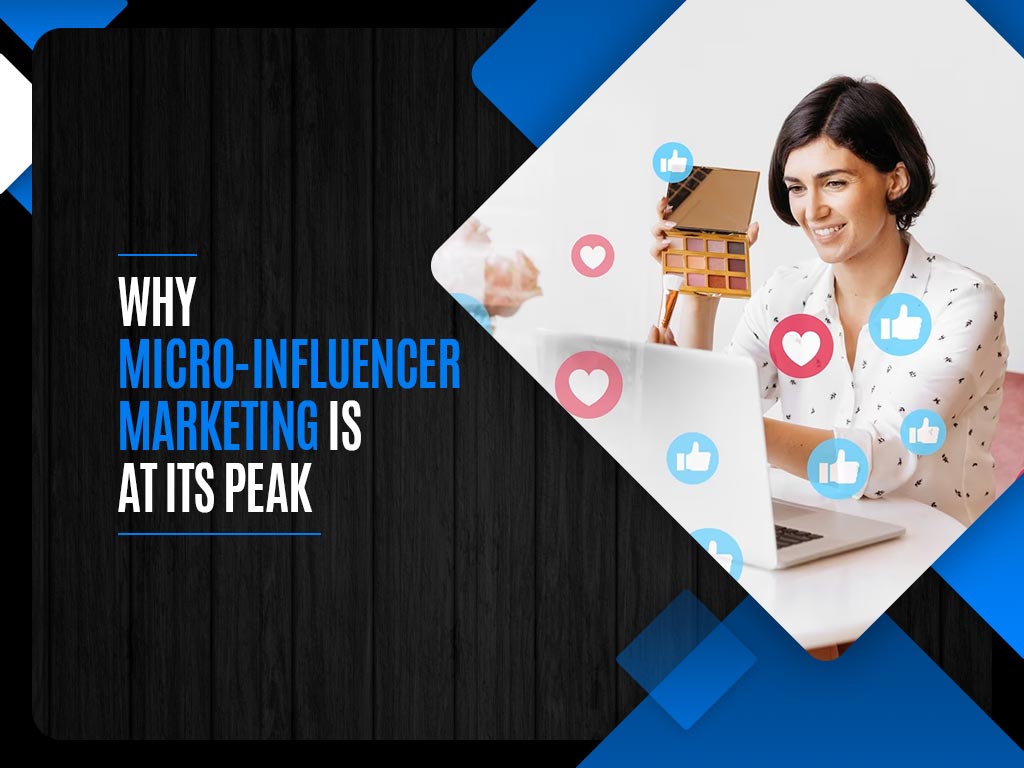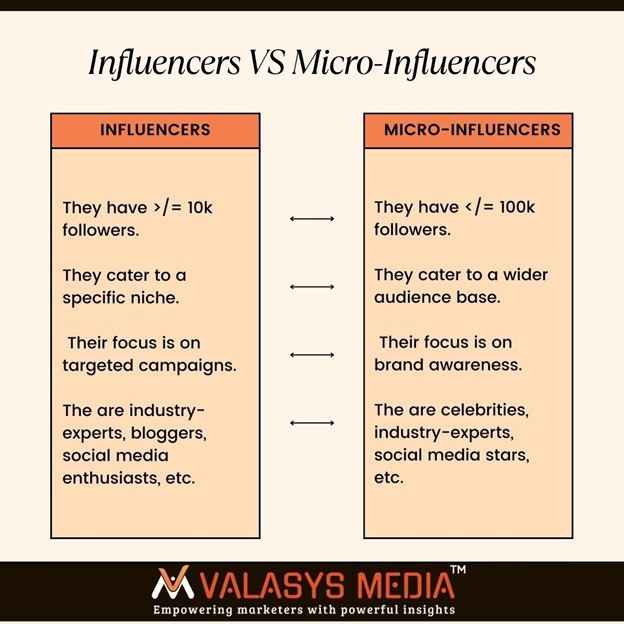Why Micro-Influencer Marketing is at its peak?

How often have you bought a product because you like the brand ambassador or trust their views? I’m sure the answer is more than just once because the virality and FOMO (Fear of Missing Out) have led us to buy things we didn’t precisely need, but we went ahead and bought them just because our favorite influencers were promoting it and peer pressure caved in!
Statistics also say the same. As per a survey, the success rate says for every dollar spent on influencer marketing, a return of $5.78 can be expected. Micro-influencer marketing is a relatively new concept similar to influencer marketing but on a smaller scale.
Micro-influencers are influencers of a smaller scale – typically, they have a following ranging between 1000 to 10,000 followers. For a clearer picture, let us look at the differences between an influencer and a micro-influencer:
The question that may arise here is why choose micro-influencers at all?
PROS:
Micro-influencers are better than influencers in that they cater to a very niche audience and boast brand loyalty from their followers. Though small in numbers, their followers are extremely loyal and close-knit, giving the micro-influencers an edge in terms of the rate of conversions. Micro-influencer marketing is also more affordable as they charge less and are more willing to collaborate.
Having said that, there are some setbacks as well.
CONS:
Micro-influencers, due to their smaller followings, inherently possess a limited reach, which can pose challenges when targeting a broader audience in your campaign. Furthermore, their relatively limited experience collaborating with brands may present difficulties in crafting and delivering premium-quality content.
However, you can overcome these setbacks by selecting micro-influencers whose niches align with your campaign’s objectives and who boast engaged audiences, ensuring your message reaches the most pertinent individuals and yields the intended outcomes.
Outreach Strategies for Micro-Influencer Marketing
To develop a successful micro-influencer campaign, you need to have a compelling outreach strategy in place. Here are some of the important points for you to keep in mind while drafting your outreach strategy:
- Your goals for the campaign: Are you looking to increase brand awareness, drive traffic to your website, or generate sales?
- The type of content you are looking for: Do you want the influencers to create blog posts, social media posts, videos, or something else?
- The compensation you are offering: Micro-influencers typically charge a fee for sponsored content, but you may also be able to provide them with other forms of compensation, such as free products or services.
- Personalize your outreach messages: Take the time to learn about each influencer and tailor your message accordingly. This shows that you are genuinely interested in working with them.
- Highlight your brand’s value proposition: Explain to the influencers why your brand is a good fit for their audience and what they can offer their followers.
- Make it easy for the influencers to say yes: Provide clear guidelines for the campaign, including the type of content you are looking for, the deadline, and the compensation you offer.
- Follow up promptly: Respond to the influencers’ messages quickly and professionally.
Once you have sent your outreach messages, it is imperative to be patient while awaiting responses from potential influencers. It must be taken into account that evaluating your proposal and determining their interest may necessitate some time. Striking the right balance is crucial—displaying eagerness without conveying desperation and demonstrating respect for their time and standing in the industry.
Consider initiating a polite follow-up if a considerable period passes without a response. Maintaining backup plans in your strategy ensures your objectives remain on track.
Measuring Micro-Influencer ROI
Measuring the ROI of a micro-influencer marketing campaign can be challenging, but it is vital to do so to track the success of your campaigns and make informed decisions about future campaigns. While every micro-influencer marketing campaign has different goals, and it is not possible to determine the success through the same parameters, listed below are some of the most common metrics that brands use to measure the ROI of their micro-influencer marketing campaigns:
- Website traffic: Track the number of visitors to your website from the micro-influencers posts.
- Social media engagement: Track the number of likes, comments, and shares the micro-influencers posts receive.
- Sales: Track the number of sales that you generate as a result of the micro-influencers posts.
- Brand awareness: Track the number of people who mention your brand or products on social media after seeing the micro-influencers posts.
It is important to note that these metrics are not always directly correlated with ROI. For example, a micro-influencer campaign that generates a lot of social media engagement may only sometimes lead to increased sales. This is why it is essential to use a variety of metrics to get a complete picture of the campaign’s success.
Micro-influencer Marketing Tools
Micro-influencer marketing tools are software platforms that help brands identify, connect with, and manage micro-influencers. You can use these tools to save time and resources and to streamline the micro-influencer marketing process.
Let us look at some of the most popular ones:
- BuzzSumo: BuzzSumo is a content marketing platform that can identify micro-influencers in a particular niche. BuzzSumo allows users to search for content by keyword, topic, or domain. It also provides insights into the engagement of different pieces of content, which can help brands identify micro-influencers with engaged audiences.
- Upfluence: Upfluence is a micro-influencer marketing platform that connects brands with micro-influencers. Upfluence has a database of over 3 million micro-influencers, allowing brands to filter influencers by niche, reach, and engagement rate. Upfluence also provides tools for managing campaigns and tracking results.
- HypeAuditor: HypeAuditor is a micro-influencer marketing platform that helps brands to identify and analyze micro-influencers. HypeAuditor provides insights into the authenticity of influencers, their engagement rates, and their audience demographics. HypeAuditor also allows brands to compare different influencers and to track their performance over time.
- Klear: Klear is a micro-influencer marketing platform that helps brands identify and manage micro-influencers. Klear has a database of over 1 million micro-influencers, and it allows brands to filter influencers by niche, reach, and engagement rate. Klear also provides tools for managing campaigns and tracking results.
- Influencer Marketing Hub: Influencer Marketing Hub is a platform that provides resources and tools for influencer marketing campaigns. Influencer Marketing Hub has a directory of over 3 million influencers and provides tools for finding, connecting with, and managing influencers.
One of the cult-favorite brands using micro-influencing like a pro is Red Bull. Red Bull is an energy drink company that has used micro-influencer marketing to promote its brand and to connect with its target audience. Red Bull partners with micro-influencers who are adventurous and daring and who have a passion for its products. These micro-influencers create and share content that is exciting and inspiring and that resonates with their followers.
Is micro-influencer marketing here to stay?
The enduring relevance of micro-influencer marketing within the B2B landscape is unmistakable, with projections indicating its sustained growth in the foreseeable future. In an era of discerning and skeptical consumers, traditional advertising channels are losing efficacy, compelling decision-makers to rely on trusted figures like micro-influencers for informed product recommendations and guidance.
Anticipated trends in B2B micro-influencer marketing encompass a heightened emphasis on authenticity, the proliferation of micro-influencer networks, the strategic deployment of AI and automation for the identification and targeting of micro-influencers, and the seamless integration of micro-influencer marketing into broader marketing avenues, including email campaigns, social media initiatives, and content marketing strategies. The bottom line is that micro-influencer marketing can be a very effective way for brands to reach their target audience and build customer relationships.
FAQs
What makes influencers so powerful?
Influencers are powerful because they have built trust and credibility with their audiences. They create and share content that is relevant and engaging, and their audiences trust their recommendations.
Why do brands prefer influencer marketing?
Brands prefer influencer marketing because it enables them to reach their prospects in an authentic and engaging way than traditional advertising. Influencers create content that is tailor-made to their target audience, and they can use their relationships with their followers to build brand awareness and trust.
Why is influencer marketing better than other marketing strategies?
Influencer marketing is more versatile than other marketing strategies because it allows brands to experiment with different types of content and reach different audiences. Brands can choose to work with influencers of all sizes, and they can target their campaigns to specific demographics and interests.


